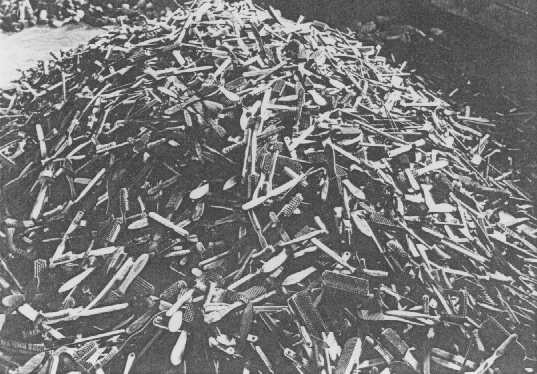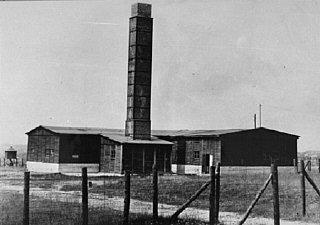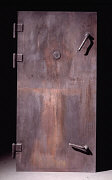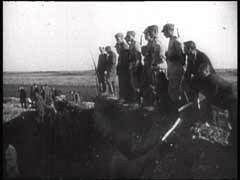
Hairbrushes of victims, found soon after the liberation of Auschwitz. Poland, after January 27, 1945.
— Dokumentationsarchiv des Oesterreichischen Widerstandes
The Nazis established killing centers for efficient mass murder. Unlike concentration camps, which served primarily as detention and labor centers, killing centers (also referred to as "extermination camps" or "death camps") were almost exclusively "death factories." German SS and police murdered nearly 2,700,000 Jews in the killing centers either by asphyxiation with poison gas or by shooting.
CHELMNO, BELZEC, SOBIBOR, AND TREBLINKA
The first killing center was Chelmno, which opened in the Warthegau (part of Poland annexed to Germany) in December 1941. Mostly Jews, but also Roma(Gypsies), were gassed in mobile gas vans there. In 1942, in the Generalgouvernement (a territory in the interior of occupied Poland), the Nazis opened the Belzec, Sobibor, and Treblinkakilling centers (known collectively as the Operation Reinhard camps) to systematically murder the Jews of Poland. In the Operation Reinhard killing centers, the SS and their auxiliaries killed approximately 1,526,500 Jews between March 1942 and November 1943.
The first killing center was Chelmno, which opened in the Warthegau (part of Poland annexed to Germany) in December 1941. Mostly Jews, but also Roma(Gypsies), were gassed in mobile gas vans there. In 1942, in the Generalgouvernement (a territory in the interior of occupied Poland), the Nazis opened the Belzec, Sobibor, and Treblinkakilling centers (known collectively as the Operation Reinhard camps) to systematically murder the Jews of Poland. In the Operation Reinhard killing centers, the SS and their auxiliaries killed approximately 1,526,500 Jews between March 1942 and November 1943.
AUSCHWITZ-BIRKENAU
Almost all of the deportees who arrived at the camps were sent immediately to death in the gas chambers (with the exception of very small numbers chosen for special work teams known as Sonderkommandos). The largest killing center was Auschwitz-Birkenau, which by spring 1943 had four gas chambers (using Zyklon B poison gas) in operation. At the height of the deportations, up to 6,000 Jews were gassed each day at Auschwitz-Birkenau in Poland. Over a million Jews and tens of thousands of Roma, Poles, and Soviet prisoners of war were killed there by November 1944.
Almost all of the deportees who arrived at the camps were sent immediately to death in the gas chambers (with the exception of very small numbers chosen for special work teams known as Sonderkommandos). The largest killing center was Auschwitz-Birkenau, which by spring 1943 had four gas chambers (using Zyklon B poison gas) in operation. At the height of the deportations, up to 6,000 Jews were gassed each day at Auschwitz-Birkenau in Poland. Over a million Jews and tens of thousands of Roma, Poles, and Soviet prisoners of war were killed there by November 1944.
MAJDANEK
Though many scholars have traditionally counted the Majdanekcamp as a sixth killing center, recent research had shed more light on the functions and operations at Lublin/Majdanek. Within the framework of Operation Reinhard, Majdanek primarily served to concentrate Jews whom the Germans spared temporarily for forced labor. It occasionally functioned as a killing site to murder victims who could not be killed at the Operation Reinhard killing centers: Belzec, Sobibor, and Treblinka II. It also contained a storage depot for property and valuables taken from the Jewish victims at the killing centers.
Though many scholars have traditionally counted the Majdanekcamp as a sixth killing center, recent research had shed more light on the functions and operations at Lublin/Majdanek. Within the framework of Operation Reinhard, Majdanek primarily served to concentrate Jews whom the Germans spared temporarily for forced labor. It occasionally functioned as a killing site to murder victims who could not be killed at the Operation Reinhard killing centers: Belzec, Sobibor, and Treblinka II. It also contained a storage depot for property and valuables taken from the Jewish victims at the killing centers.
The SS considered the killing centers top secret. To obliterate all traces of gassing operations, special prisoner units (the Sonderkommandos) were forced to remove corpses from the gas chambers and cremate them. The grounds of some killing centers were landscaped or camouflaged to disguise the murder of millions.
Resources
Wiesel, Elie. Night. Trans. Marion Wiesel. New York: Hill and Wang, 2006.
Levi, Primo. Survival in Auschwitz. Trans. Stuart Woolf. New York: Simon & Schuster, 1996.
*****
Arad, Yitzhak. Belzec, Sobibor, Treblinka: The Operation Reinhard Death Camps. Bloomington: Indiana University Press, 1987.
Arad, Yitzhak. Belzec, Sobibor, Treblinka: The Operation Reinhard Death Camps. Bloomington: Indiana University Press, 1987.
Berenbaum, Michael, and Yisrael Gutman, editors. Anatomy of the Auschwitz Death Camp. Bloomington: Indiana University Press, in association with the United States Holocaust Memorial Museum, 1998.
Chrostowski, Witold. Extermination Camp Treblinka. London: Vallentine Mitchell, 2004.
Delin, Grant. Lebensraum: Extermination Camps of the Third Reich. London: Westzone Publishing, 2001.
Hilberg, Raul. The Destruction of the European Jews. New Haven, CT: Yale University Press, 2003.
Mendelsohn, John, editor. The "Final Solution" in the Extermination Camps and the Aftermath. New York: Garland Publishing, 1982.
Schelvis, Jules, and Bob Moore. Sobibor: A History of a Nazi Death Camp. Oxford: Berg, 2007.





No comments:
Post a Comment